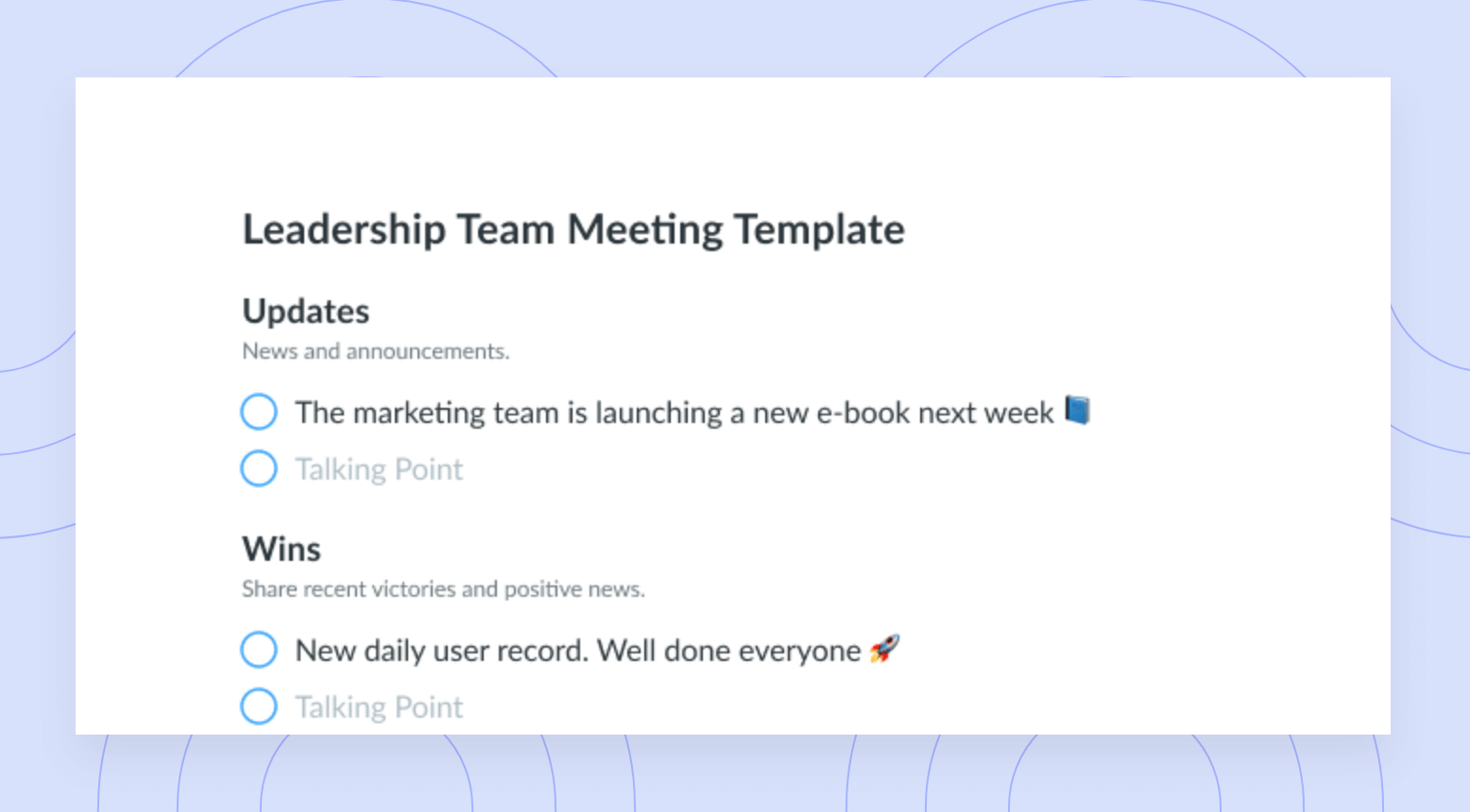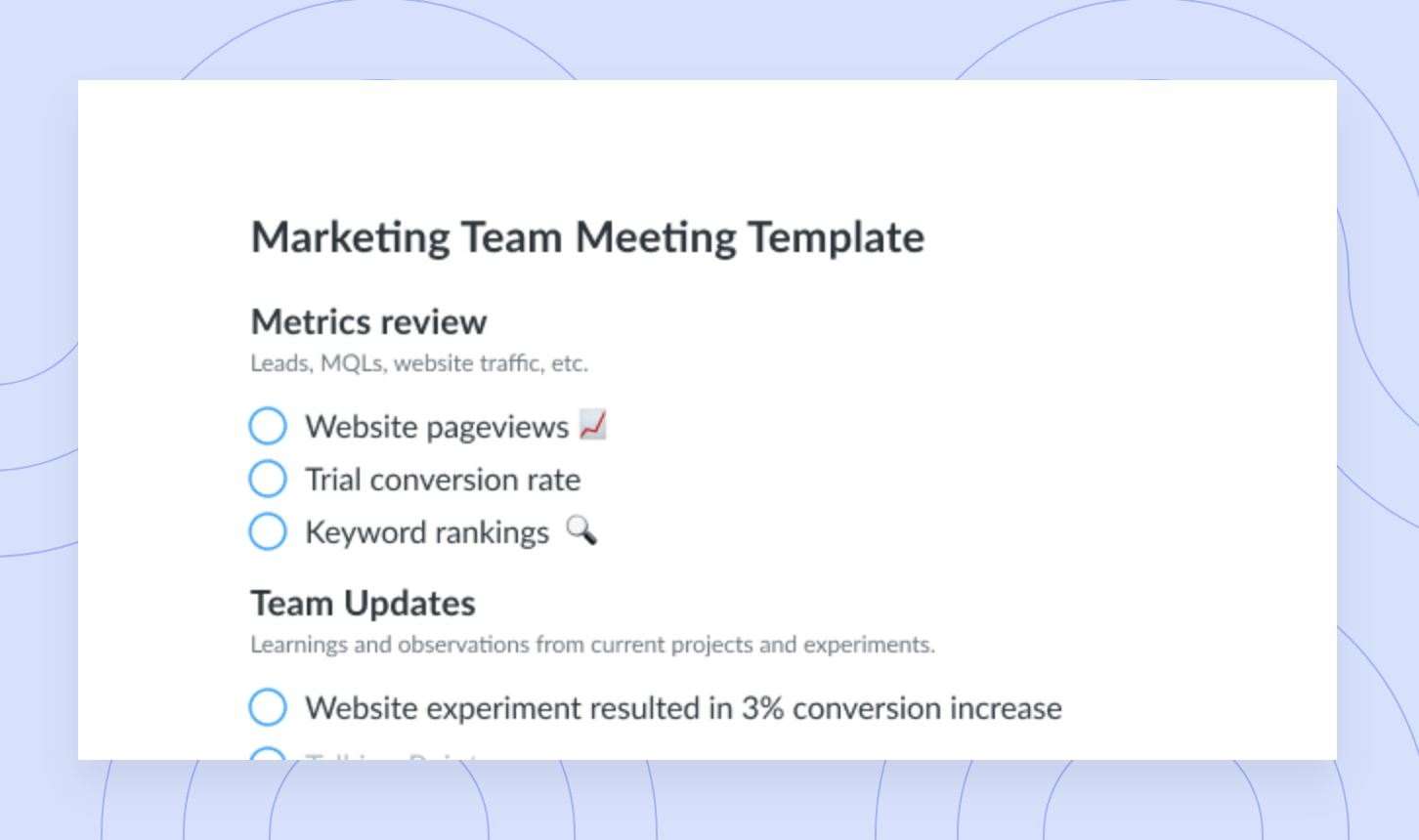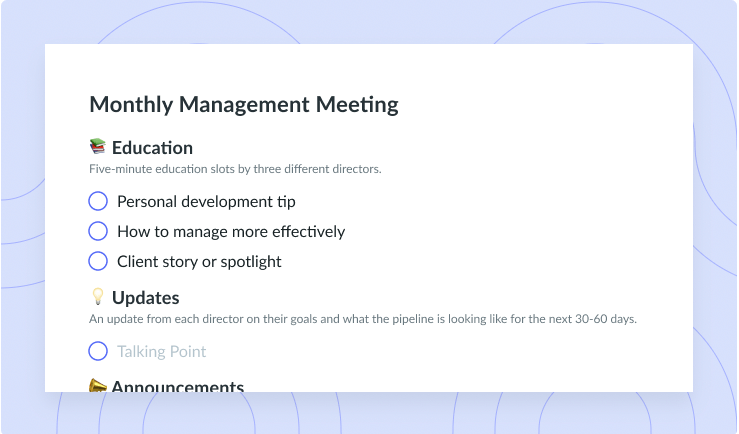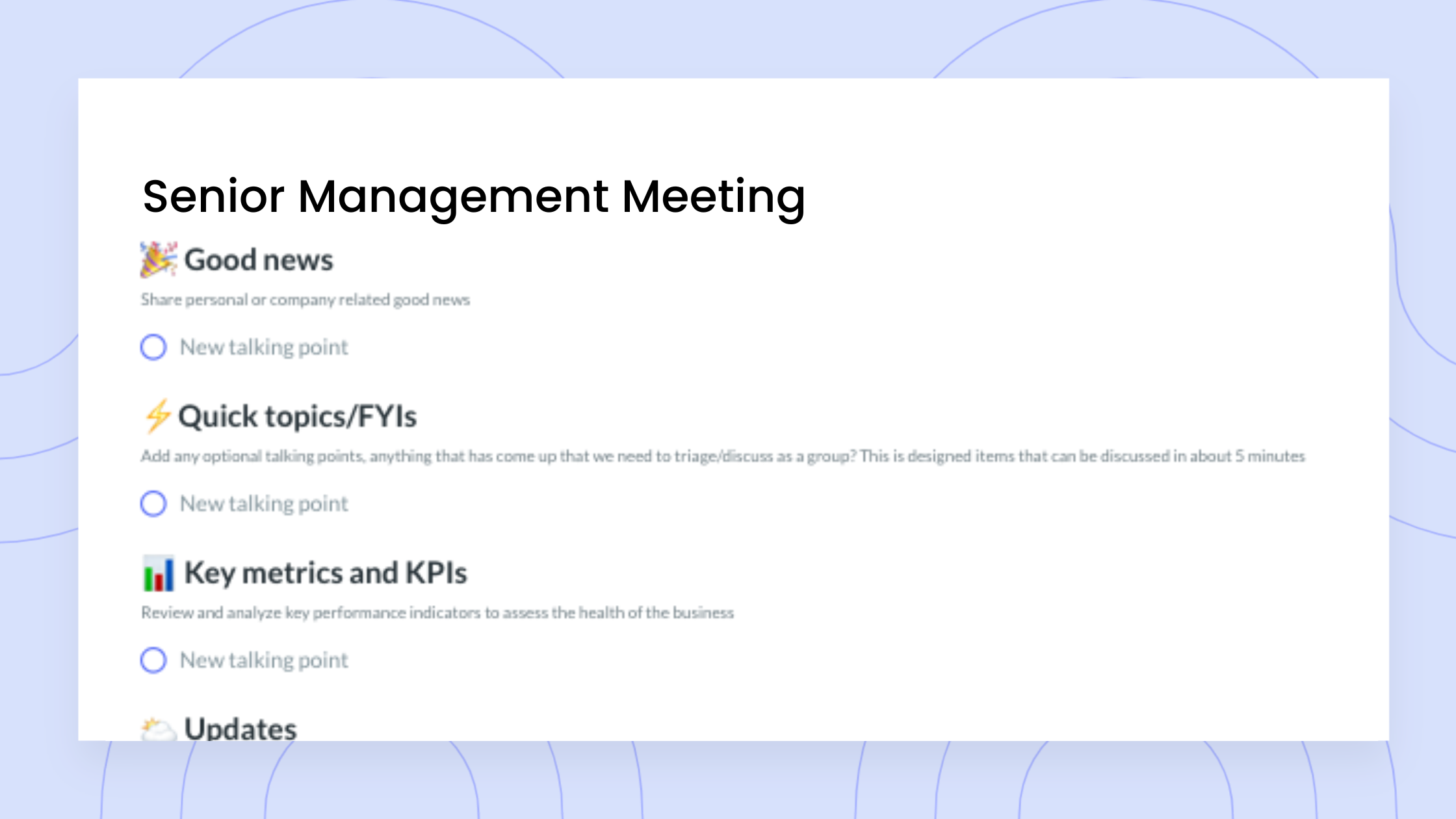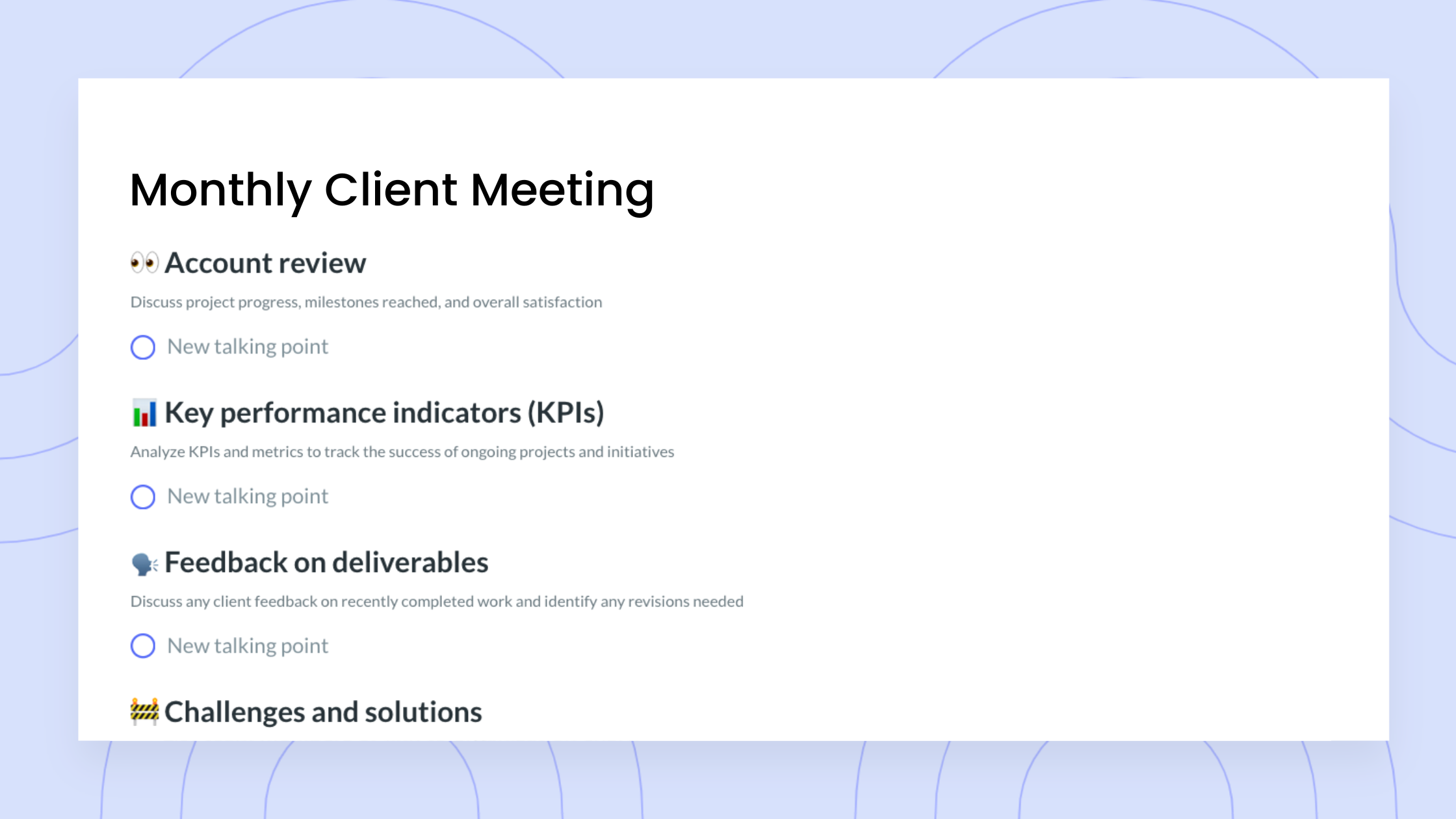Management Meeting Agenda: How to Run a Leadership Meeting
Learn about the importance of management meetings and what to include in these leadership meeting agendas.
Effective leaders like yourself are more than bosses. You’re also figureheads who drive employee productivity and engagement. And we’re not just saying this to motivate or inspire you: We’re also saying this because your meetings should also be productive and engaging… but are they?
Surely, you’ve held meetings that have felt like total slogs, but we’re here to tell you that it really doesn’t need to be this way. Your management meetings are a great place to work toward making your meetings as informative as they are exciting.
Holding regular management meetings can help you establish and grow solid leadership in your company. In this article, you’ll learn more about the importance of these meetings and how to create a management meeting agenda for a productive meeting.
- Why are management meetings important?
- How does a management meeting differ from a normal meeting?
- How to structure management meeting agenda
- 9 items you need on the meeting agenda
Why are management meetings important?
Management meetings are a big deal. They bring your company’s leaders together to solve all kinds of problems, all with the ultimate goal of boosting your team’s performance. These meetings also foster communication and mutual understanding among everyone in leadership. This way, all your departments can function harmoniously and toward the same company goal.

Pro tip
Use a meeting management tool like Fellow to have collaborative, organized meeting agendas to get the most done in your allotted time.
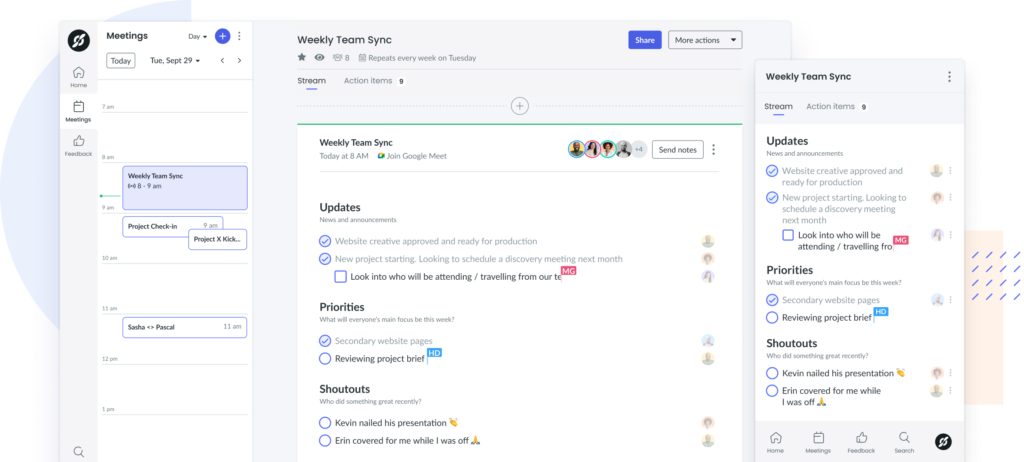
How does a management meeting differ from a normal meeting?
There are a few key differences to know about the difference between a management meeting and other types of meetings:
- Audience. You can probably guess the most obvious distinction between management and normal meetings: who’s in the room. Managers, supervisors, team leads… they’re your listening ears at a management meeting. Your typical staff meeting, however, might include employees, contractors, and even interns. You’ll change the topics you need to cover based on your audience – managers might be privy to things other team members never need to hear.
- Experience. Managers inherently have more experience than other team members, and the conversations will likely change to reflect that. In a management meeting, you’ll discuss information that only the management level is privy to know, or you’ll task management with disseminating certain information with their team members.
- Agendas. Put a management meeting agenda next to a normal meeting agenda, and you might not even realize the two meetings happened within the same company! These two agenda types look super different. Management meetings center key company decisions to move the company forward, whereas other meetings may focus on team progress based on what your leadership has implemented. Management meetings don’t need the kind of daily ins and outs that regular team meetings will cover.
How to structure a management meeting agenda
People in upper management positions spend up to 50 percent of their workdays in meetings. Yes, that’s a lot, and you sure have to make the best of it!
You’ve heard the saying that time is money, right? Here’s another way to look at this phrase: Unproductive meetings can be costly. They take time away from other important work and responsibilities without achieving much. Well-organized discussions and decision-making processes solve this problem, and you can’t quite achieve either of these goals without an effective meeting management agenda. Here’s how to structure yours.
- Identify your meeting’s goal
- Create specific objectives
- Organize reports
- Estimate the amount of time you’ll need
- Leave room for discussion
- End the meeting with a review
1 Identify your meeting’s goal
Without a clear goal for your meeting, your conversations could drift off into unintended directions. These side chats can cause confusion, waste time, and have your attendees leaving your meeting asking, “What was the point of that meeting? What do we need to do next?”
Before you plan your meeting, write a meeting purpose statement. This way, you have a clear meeting goal that tells your co-leaders what will be discussed. Your goal will also tell attendees how they can contribute in relevant, meaningful ways.
2 Create specific objectives
Meeting objectives tell your team what must be accomplished by the end of the meeting. Setting these objectives can help you assign action items to complete afterward. See how this is setting you up to have a productive meeting? Stay on top of your team’s goals by clearly recording, defining, and tracking the progress of your OKRs in Fellow’s Objectives tool. The best part? You can quickly review those objectives during your team meetings!
3 Organize reports
A management meeting is a great opportunity to check in with your fellow leaders. For example, you might ask the head of each department to give a brief report on their team’s performance and current challenges. In that case, you could create a block in your agenda for “reports,” but you could also take that a step further.
Try dedicating a section in your agenda to each team’s report. This way, your meeting will stay organized and on track since each person will know when they can speak and for how long.
4 Estimate the amount of time you’ll need
Your agenda needs a strong tether to time so you don’t rush through your points during your meeting or run long. You can put items of higher importance at the top of your agenda to ensure they’re covered. You can also add a time limit next to each meeting objective so you can allocate enough time for your team to complete them.
5 Leave room for discussion
It can be easy to fixate on watching the clock to give yourself just enough time to present your points. But if your leadership meeting is about explaining a new concept, making time for discussion should be a priority as you prepare for your meeting.
Making room in your agenda for others to raise any questions or concerns shows you value everyone’s opinions. It also ensures that your co-leaders thoroughly understand what they need to do after the meeting. This way, your whole team gets seamlessly put on the same page. And the best teams work from equal ground.
6 End the meeting with a review
Wrapping up with a review helps dispel any confusion that might linger at the end. Recap any objectives that remain incomplete, and solidify important answers you gave to key questions. This way, everyone walks out of the meeting with all the next steps fresh on their minds and important action items at the top of their to-do lists.
The end of your meeting is also a great opportunity to ask for feedback. After all, your meeting isn’t just for you – it’s for everyone else present. So if you can do things how they prefer, your meetings will be more successful. And if you’re regularly holding successful meetings, that bodes well for everyone!
The 9 items you need on your management meeting agenda
Properly structuring your meeting agenda is step one of two. Your structure should support the inclusion of the below nine management meeting agenda items. These items can help set meeting goals, track progress, and keep everyone at the table engaged.
- Personal updates
- Good news
- Metrics and KPIs
- Priorities
- Wins and insights
- Messages to share
- Spotlight
- Issues
- Goals for the week, month, or quarter
1 Personal updates
Picture this: It’s Monday, and after a relaxing weekend, you dive straight into a 9 a.m. meeting that starts with serious business. Rough transition, right? Meeting check-in questions can make the start of any meeting, no matter the time or day of the week, much smoother.
Checking in with your leadership team shows that you care about their well-being and gives them space to address any work concerns. Try asking attendees to share how they’re feeling in a couple of sentences or use an ice breaker to, well, break the ice. And include yourself too! Being transparent can help build trust and improve team communication.
2 Good news
Hearing some good news can be a breath of fresh air during a hectic workday. Starting your meeting with positive stories can make attendees feel more optimistic and decrease their stress and anxiety levels. That can be a company-wide success, a great team win, or even some personal good news.
3 Metrics and KPIs
If the first two items on your management meeting agenda loosen everyone up for a great meeting, then the key performance indicator (KPI) section is when the business stuff really starts. KPIs evaluate how effectively your team (or whole company) is completing business objectives, so they’re the bread and butter of any management meeting. Start with them to set the stage for the rest of your conversation.
Examples of KPIs include revenue, customer satisfaction, client retention rates, and profit margins. These numbers quickly summarize for others in management precisely what your teams are working toward and how close they are to reaching them.
4 Priorities
When you set priorities, you focus your team on actions that move your company forward. In other words, you put tasks on your lists. To determine how to prioritize tasks, assess criteria like deadlines, revenue impacts, feasibility, and long-term benefits. You can use KPIs to evaluate the importance of certain tasks based on what each task contributes to your project.
5 Wins and insights
As a manager, you spend lots of time orchestrating your company’s operations behind the scenes. That makes it pretty easy to feel like you’re overworked and underappreciated. And chances are that, at your management meeting agenda, lots of other people feel the same. Sharing your wins and insights gets you that much-needed appreciation while providing insights for future planning.
Asking your leaders to share their team’s wins can shine a big light on your staff’s successes and growth. These insights can also illustrate how your team is positively impacting clients and advancing your company’s vision.
6 Messages to share
At its core, the purpose of any meeting, whether it involves solely leaders or the whole company, is to advance your business and its people. Your management meeting agenda should include time for messages that prepare your leaders to do exactly these two things. Your messages can be instructional or inspirational in nature, and your leaders should be able to relay them to their teams too.
7 Spotlight
Imagine you and your leadership team are sitting next to each other on a dark stage. Suddenly, a bright light clicks on, illuminating one person while they tell an intriguing story. The spotlight portion of your meeting is like this, but with a little less Broadway-esque drama.
A spotlight allows each person to share their progress on a project as well as any issues or roadblocks they’re facing. Sharing these points allows the rest of the team to offer advice and follow successful examples.
8 Issues
As good as it feels to celebrate your team’s wins and successes, it’s important to also discuss issues inhibiting your company’s progress. As you identify roadblocks, discuss solutions rather than leaving these challenging stones unturned. To keep morale high during intense conversations, emphasize your leaders’ strengths and offer solutions that your co-leaders can immediately implement.
9 Goals for the week, month, or quarter
Working toward a goal can give you and your fellow managers a feeling of purpose as you power through tasks on a lengthy to-do list. In fact, a Michigan State University study found that 76 percent of participants successfully achieved their goals after writing them down and regularly discussing their progress with someone. Setting attainable goals for your team leaders and regularly discussing them can spark their motivation while allowing progress to be tracked.
Make time during your meeting to set goals that align your team’s focus and allow everyone to hold each other accountable. (This accountability structure is sometimes known as team ownership.) Defining a timeframe for these goals sets deadlines for your team and allows you to keep assigning new goals to advance their progress. And then, you can add check-ins on this progress to your next management meeting agenda.
Leaders of tomorrow, leading today
Planning an effective management meeting starts with an agenda that engages your co-leaders and helps them advance their leadership. With the tips in this article, preparing your agenda and sticking to it for effective management meetings should be a cakewalk. Plus, for both management meetings and other meeting types, Fellow can help you create agendas, assign meeting action items, and guide your leaders and their teams to success.



![How to Run an Effective Weekly Team Meeting [Free Agenda Templates]](https://fellow.app/wp-content/uploads/2019/10/Weekly-Team-Meeting-Agenda-Template.jpg)


![How to run a Leadership Team Meeting [Compatible with EOS®]](https://fellow.app/wp-content/uploads/2020/10/Stock-Photos-1.jpg)
![Crisis Management: How to Overcome a Business Crisis [+ Free Template]](https://fellow.app/wp-content/uploads/2022/06/Crisis-Management-2.jpg)


